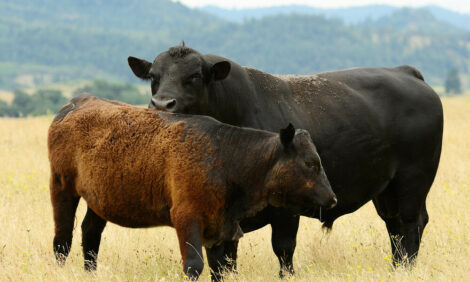



Cornell Model Helps Dairy Farms Reduce Nitrogen, Save Money
US - The Chesapeake Bay - about 235 miles down the Susquehanna River from New York's Southern Tier - and other waterways might grow cleaner, thanks to new updates and improvements in a Cornell dairy nutrition model.
[Photo: Jason Koski, Cornell University]
The Cornell Net Carbohydrate and Protein System (CNCPS) is a model that helps farmers determine what to feed dairy cows to make milk production more efficient and environmentally friendly. And while less nitrogen makes its way into the manure and subsequent rain runoff flowing into the bay, farmers also might save money, according to research published in February in the journal Applied Animal Science.
Through on-farm research in Broome, Tioga and Delaware counties in New York, co-authors Michael Van Amburgh, professor of animal science, and Larry Chase, professor emeritus of animal science, found that farmers can feed cows less protein, maintain a cow's milk-production output and reduce nitrogen in the manure, so that the nutrient does not run off into waterways and lakes.
"I call it a win-win. The dairy farmers win because the cow is more efficient and more profitable. Society wins because we're now putting fewer nutrients back into the environment or into the water than we would have had we not made the adjustments," said Professor Chase.
Cows at the eight farms studied in the Southern Tier averaged about 14 percent less nitrogen in their manure.
Excess nitrogen from farm runoff into rivers, creeks and other waterways can promote unwanted algae in lakes, reservoirs or even bays such as the Chesapeake.
On one 50-cow farm, the researchers found the initial amount of protein in the feed was 16.3 percent. Using the updated CNCPS program, the percentage dropped to 14.9 percent. In the farm's manure output, there was 1,607 fewer pounds of nitrogen put into the environment annually with no change in milk production.
On a 565-cow farm, the protein feed input dropped 1 percent, which resulted in nearly 80 fewer grams of nitrogen in cow's manure daily, thus reducing nitrogen excretion by 18.6 percent. That translates into 35,916 fewer pounds of nitrogen placed into the environment annually, again without negatively impacting milk yield.
In their research, Professor Chase and Van Amburgh noted that reducing the protein portion of the feed to enhance efficiency also saves farmers money. Using 2017 feed prices as a base, a farmer can save between $147 and $157 per cow annually.
Said Professor Van Amburgh: "We are improving the economic margin of dairy farms - while at the same time reducing nitrogen output and helping the environment. We're all better off."
TheCattleSite News Desk


